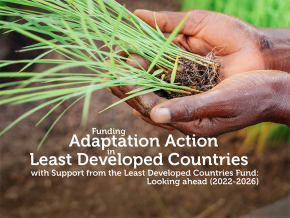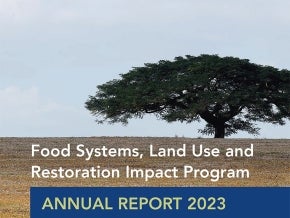Adapting to the Himalayan meltdown: Reducing the risk of glacial lake outburst floods in Bhutan

“On any given day, I am more than happy to walk visitors up to Samdingkha, to introduce them to our ever-vigilant village ‘watchperson’ – the siren that warns us of chhuri (Dzonghka for ‘glacial lake outburst floods’). Just being near it and seeing it overlook the valley makes me feel safe and reassured that today, I am better prepared to face a disaster – unlike what happened 22 years ago.
I still remember that October morning in 1994, when I saw about 40 of my community members being suddenly swallowed by giant, unforgiving river waves. I could do nothing but stand there and witness my friends and neighbors disappear with the water.
Having seen the 1994 chhuri myself, it was easy to understand and encourage community members to participate in the planning for disaster preparedness that was introduced by the GLOF project.
I was a representative of a village land committee when the project started works here. The high flood-risk areas were mapped and escape routes for immediate evacuation to higher grounds were identified. People were also discouraged from building structures in high-risk areas along the river.
The project activities have served as a constant reminder to people of what could happen – otherwise, they tend to forget about it as time passes by and take things for granted. The project has helped us face up to and deal with our fear of possible chhuri - we now have a plan. We have also found that the local Government officials are now planning for disaster risk reduction during the development planning process – before, they focused only on planning for basic necessities, such as building roads and schools.
I wish that the current early warning system was in place back in 1994. Things would not have ended the way they did.”
AGAY DOPHU is an 82 year-old farmer who lives in Samdingkha village in the Punakha Valley, in Bhutan. He is a survivor of the catastrophic glacial lake outburst flood (GLOF) that occurred in 1994. At the time, he was a Gup – a village headman.
“I first experienced the use of the early warning system built by the project, when Lemthang tsho burst upstream of the Mochhu river. Although the water did not rise to danger level, we did not want to take chances, as it happened at night when people are off-guard. So we manually triggered the siren to warn people to evacuate to safe grounds. Now that I reflect on it, it was a good opportunity to check that the system actually works!
In July this year, a similar situation developed. We were regularly getting worrying news on floods from the southern districts, and we went beyond our usual schedule to monitor river levels. It haunted us for the entire month with sleepless nights.
The important thing is that we are now able to provide information on river levels to Punatshangchhu project authorities as well as officials downstream of us in India, on a daily basis – and sound the warning when there is danger. And we know that it works.”
MR. JAI RAM RAI is a 28 year old Junior Engineer who is in charge of the Early Warning System Control Room at Wangduephodrang, downstream of Samdingkha.
”Being a climate-sensitive sector, we at Punatshangchhu Hydro Projects quickly recognized the importance to us of the activities implemented by the GLOF project – this is why we contributed co-finance from our security budget.
Through this project, we realized the importance of having a well thought-out disaster management plan, and now have our own GLOF disaster contingency plan. With this, if a flood were to occur today, we would be able to evacuate around 10,000 workers, and expensive machinery, to safe grounds within two and a half hours after the siren goes off. This would never have been possible before.
We have been made aware of the impending threats posed by GLOF due to climate change, and have the knowledge and equipment to be better prepared. This protects lives, personal property and infrastructure.”
CAPTAIN KELDEN DRUKPA is a Deputy- Chief Security Officer at Punatshangchhu Hydropower Project Authority. He is responsible, around the clock, for the safety of thousands of workers and expensive equipment.
In 1994, a flood from a glacial lake named Lugge tsho resulted in devastating loss of life, property and livelihoods for the communities living downstream in the Punakha-Wangdue valleys – this was the event described by Angay Dophu. As the climate of the Himalayan region grows warmer, there is increased risk of glacial lake outburst flooding (GLOF), a phenomenon in which the natural barriers that hold back the glacial meltwater break suddenly, resulting in catastrophic floods. In Bhutan, there are 677 glaciers and 2,674 glacial lakes, 25 of which pose a high risk of flooding. Amongst these, Lake Thorthomi has been identified as one of the most dangerous.
To assist Bhutan in their efforts to build adaptive capacity to climate-induced disasters, UNDP has supported the implementation of a project (known as ‘NAPA 1’) to reduce risks from glacial lake outburst floods in the Punakha, Wangdue and Chamkhar Valleys. The project physically lowered the level of Lake Thorthomi to reduce the risk of flooding, simultaneously contributing to local enterprise development and job creation. The project also strengthened disaster-preparedness by installing automated Early Warning Systems and building the capacity of the community to respond better to natural disasters. The work was funded jointly by the GEF (through the Least Developed Countries Fund) and UNDP, with co-financing from the Royal Government of Bhutan, and other partners. Since the project closed in 2013, the Government of Bhutan constantly monitors water levels in the glaciers and glacial lakes, and has installed an Early Warning System in another at-risk river system, where hydropower facilities are soon to be built. GEF support for a second GLOF project (known as ‘NAPA II’) will make it possible to set up additional automated hydro-meteorological stations across the country and to establish a National Weather and Flood Forecasting and Warning Centre.
This story was originally published in "Voices of Impact: Speaking for the Global Commons" by UNDP in 2016.


